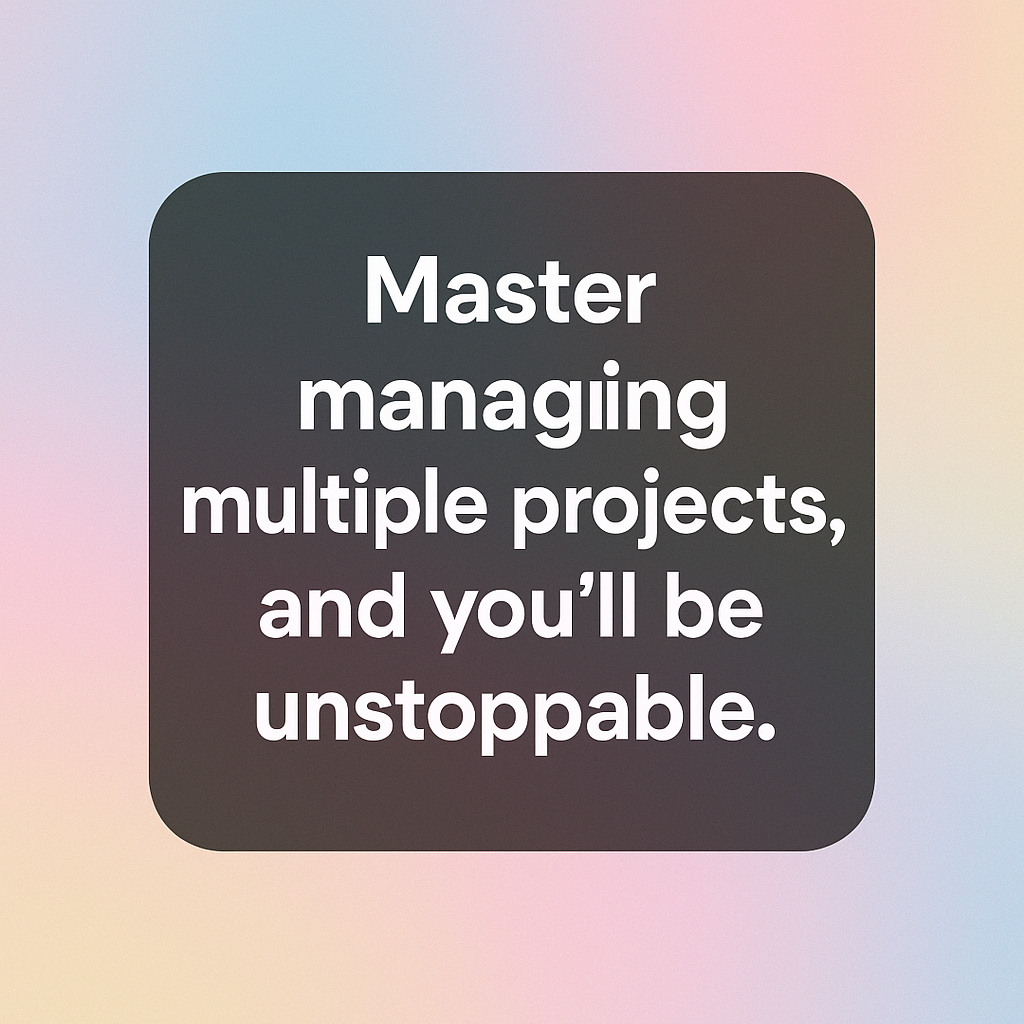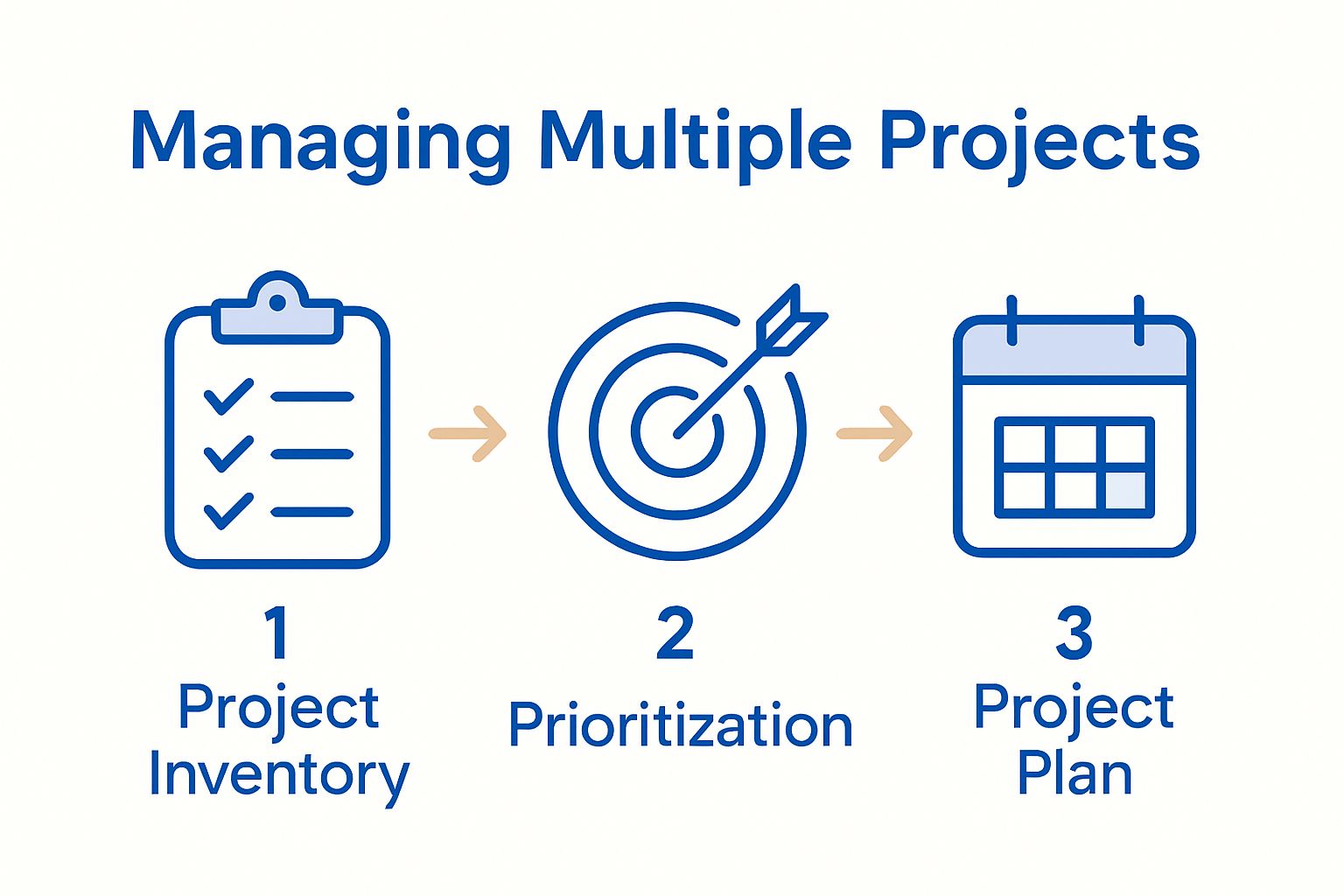
Managing multiple projects at once sounds overwhelming, especially when deadlines are tight and priorities compete for attention. However, research shows that using structured methods like time blocking and visual project tracking can actually increase overall productivity by up to 25 percent. Most people believe you need to hustle nonstop to keep up, yet the real secret is building a simple, organized framework that keeps chaos at bay and lets you stay ahead.
Table of Contents
- Step 1: Assess Your Current Project Landscape
- Step 2: Define Clear Priorities And Objectives
- Step 3: Create A Comprehensive Project Plan
- Step 4: Utilize Effective Time Management Techniques
- Step 5: Monitor Progress And Adjust As Necessary
Quick Summary
| Key Point | Explanation |
|---|---|
| 1. Assess your project landscape first | Document all projects for clear visibility. This includes tracking status, timelines, and resource requirements for efficient management. |
| 2. Define clear priorities for projects | Use a prioritization matrix to rank projects based on urgency, importance, and alignment with goals. This ensures effective time and resource allocation. |
| 3. Create detailed project plans | Break down projects into actionable tasks with specific timelines and milestones. This aids in organization and focused execution. |
| 4. Implement effective time management | Utilize time blocking and techniques like the Pomodoro Technique to enhance productivity and maintain focus across multiple projects. |
| 5. Monitor progress regularly | Establish weekly reviews and visual tracking methods to assess project statuses, identify risks, and make necessary adjustments swiftly. |
Step 1: Assess Your Current Project Landscape
Successfully managing multiple projects begins with a comprehensive understanding of your current workload and project ecosystem. This initial step provides a critical foundation for strategic planning and efficient execution. By carefully mapping out your existing projects, you create a clear visual representation of your professional commitments and potential resource constraints.
Conducting a Thorough Project Inventory
Start by gathering all active and pending projects into a single comprehensive overview. Pull out your existing project documents, contracts, client communications, and task lists. Write down each project with key details including project name, client or stakeholder, current status, estimated completion date, and required weekly time commitment. According to the Project Management Institute, understanding the full scope of your project portfolio is essential for effective management.
Consider creating a master project tracking document that allows you to see everything at a glance. This might be a spreadsheet or a digital project management tool that helps visualize project timelines, dependencies, and potential overlap. Color code projects by status or priority to make the information more digestible. Pay special attention to projects with similar deadlines or those requiring overlapping skill sets.
As you compile this inventory, look for potential bottlenecks or areas of potential conflict. Are there projects that require similar resources or expertise? Do you have consecutive deadlines that might create undue stress? Identify these potential challenges early to develop proactive mitigation strategies.
Verify your project landscape assessment by checking that you have:
- Documented all current and pending projects
- Noted specific timelines and estimated time requirements
- Highlighted potential resource conflicts or overlapping deadlines
- Created a centralized tracking method for ongoing monitoring
This initial assessment transforms managing multiple projects from an overwhelming challenge to a structured, manageable process. By gaining clarity on your total workload, you set the stage for strategic prioritization and efficient resource allocation in the subsequent steps of project management.
Use this checklist table to make sure you’ve thoroughly assessed your project landscape before moving forward with planning and prioritization.
| Verification Step | Details/Considerations |
|---|---|
| Document all current and pending projects | List every active, paused, and upcoming project |
| Note specific timelines and required time estimates | Include estimated completion dates and weekly time commitments |
| Highlight potential resource conflicts | Identify overlapping deadlines, shared resources, or expertise |
| Centralized tracking method created | Set up a master tracker (spreadsheet or digital project tool) |
| Color coding by status or priority | Use visual cues to make data digestible and quickly scannable |
| Identify potential bottlenecks and conflicts | Find areas where deadlines or skills overlap |
| Proactive mitigation strategies defined | Make note of any issues and possible solutions ahead of time |
Step 2: Define Clear Priorities and Objectives
After mapping your project landscape, the next critical step in managing multiple projects is establishing clear priorities and precise objectives. This process transforms your comprehensive project inventory into a strategic roadmap, ensuring you allocate your time and energy most effectively. Prioritization is not just about determining what needs to be done, but understanding the relative importance and potential impact of each project.
Strategic Prioritization Techniques
Begin by evaluating each project through multiple strategic lenses. Consider factors such as project revenue potential, client relationship significance, deadline urgency, and alignment with your long term professional goals. Research from Stanford University suggests using a weighted scoring system where you assign numerical values to different project attributes. This approach provides an objective framework for decision making.
Create a prioritization matrix that ranks projects based on their strategic value and immediate necessity. Classify projects into clear categories: high priority, medium priority, and low priority. High priority projects typically have tight deadlines, significant financial implications, or critical strategic importance to your business. Medium priority projects contribute to your professional growth but are not immediately time sensitive. Low priority projects can be postponed or potentially delegated.
During this prioritization process, establish specific, measurable objectives for each project. Move beyond vague intentions by defining concrete outcomes, intermediate milestones, and precise success metrics. For instance, instead of saying “complete website redesign,” define your objective as “deliver fully responsive website design with three core landing pages by September 15th, meeting client specifications for mobile optimization and user experience.”
Verify your priority and objective setting by confirming you have:
- Ranked all projects using a consistent, objective scoring system
- Defined clear, specific objectives for each project
- Identified potential conflicts or resource constraints
- Created a prioritized action plan with realistic timelines
This strategic approach to defining priorities transforms project management from a reactive process to a proactive, intentional strategy. By understanding the relative importance of each project and establishing clear objectives, you create a roadmap that maximizes your productivity and professional impact.
Step 3: Create a Comprehensive Project Plan
With your project inventory assessed and priorities established, the next crucial step is developing a comprehensive project plan that transforms strategic intentions into actionable workflows. A well constructed project plan serves as your operational blueprint, providing clarity, structure, and a systematic approach to managing multiple simultaneous initiatives.
Designing Your Integrated Project Management Framework
Begin by breaking down each prioritized project into granular, manageable tasks. For each project, create a detailed timeline that includes specific milestones, intermediate checkpoints, and final delivery dates. According to project management research from MIT, successful planning involves understanding the intricate relationships between different project components and potential interdependencies.
Utilize digital project management tools that allow for integrated tracking across multiple projects. Platforms like Trello, Asana, or Monday.com offer visual project tracking capabilities that help you monitor progress, allocate resources, and maintain a holistic view of your workload. Color coding and tagging features can help you quickly identify project status, priority levels, and potential bottlenecks.
Develop a robust task allocation strategy that considers your personal bandwidth and skill set. Assign realistic time estimates for each task, building in buffer periods to account for unexpected challenges or complex problem solving. Consider your energy levels and most productive work hours when scheduling tasks, ensuring you allocate your most demanding work during your peak performance windows. This approach prevents burnout and maintains consistent productivity across multiple projects.
Verify your comprehensive project plan by confirming you have:
- Broken down each project into specific, actionable tasks
- Created detailed timelines with clear milestones
- Identified potential resource conflicts or scheduling challenges
- Selected appropriate digital project management tools
- Allocated tasks considering personal productivity patterns
A meticulously crafted project plan transitions you from reactive task management to proactive project orchestration. By establishing a clear, integrated framework, you create a strategic approach that maximizes efficiency, minimizes stress, and positions you for successful multi project management.

Step 4: Utilize Effective Time Management Techniques
Effective time management is the linchpin of successfully managing multiple projects. This step transforms your strategic project plan into actual productivity, helping you navigate complex workloads without succumbing to overwhelm or burnout. The goal is to create a structured approach that maximizes your efficiency and maintains high quality work across all initiatives.
Strategic Time Blocking and Productivity Techniques
Implement the time blocking methodology by dedicating specific time windows to particular projects or task types. This approach prevents constant task switching and allows for deep, focused work. Divide your workday into structured segments, assigning specific projects to designated time blocks. For instance, allocate morning hours to complex, high concentration tasks and reserve afternoon periods for meetings, communications, and lighter administrative work.
According to research from Mind Tools, this intentional scheduling helps minimize cognitive fatigue and maintains consistent productivity.
Adopt the Pomodoro Technique as a complementary time management strategy. This method involves working in concentrated 25 minute intervals followed by short 5 minute breaks. During each focused interval, commit completely to a single task without interruptions. Use a digital timer or specialized productivity app to track these intervals. After completing four Pomodoro cycles, take a more extended 15 to 30 minute break. This technique helps maintain mental sharpness and prevents the diminishing returns associated with prolonged work sessions.
Develop a robust system for managing interruptions and unexpected tasks. Create a separate list for urgent but unplanned activities, allowing you to quickly capture these items without derailing your primary workflow. Consider using digital tools like Todoist or Notion that enable quick task capture and seamless integration with your existing project management framework.
Verify your time management approach by confirming you have:
- Implemented a consistent time blocking strategy
- Established clear boundaries for focused work periods
- Created a system for managing unexpected tasks
- Developed techniques to minimize task switching
- Incorporated regular breaks to maintain mental clarity
Mastering time management is not about working harder, but working smarter. By implementing these strategic techniques, you transform your approach to managing multiple projects, creating a sustainable workflow that supports long term productivity and professional success.
Step 5: Monitor Progress and Adjust as Necessary
Monitoring project progress is a dynamic, ongoing process that transforms your project management strategy from static planning to responsive execution. This critical step ensures you remain agile, catching potential issues early and maintaining momentum across multiple projects. The ability to track performance, recognize emerging challenges, and make strategic adjustments is what separates successful project managers from those constantly struggling with workload.
Creating a Real Time Tracking and Evaluation System
Establish a weekly progress review ritual where you systematically assess each project’s status against its original timeline and objectives. This is not about micromanaging but creating a consistent accountability mechanism. Conduct these reviews at a fixed time each week, using a standardized evaluation template that captures key metrics like task completion percentage, upcoming milestones, potential bottlenecks, and resource utilization. According to the Project Management Institute, regular monitoring allows for proactive risk management and strategic course correction.
Implement visual tracking tools that provide instant insights into project health. Digital dashboards in project management platforms like Asana or Monday.com offer color coded progress indicators, allowing you to quickly understand project status at a glance. Color code your projects using traffic light systems green for on track, yellow for potential risks, and red for projects requiring immediate intervention. This visual approach enables rapid decision making and helps prevent small issues from escalating into significant problems.
Develop a flexible adjustment strategy that allows for rapid pivoting when circumstances change. Instead of rigidly adhering to original plans, create contingency buffers in your project timelines. When unexpected challenges arise, have predefined alternative approaches ready. This might involve reallocating resources, adjusting deadlines, or temporarily deprioritizing less critical tasks to maintain overall project momentum.
Verify your progress monitoring approach by confirming you have:
- Established consistent weekly progress review processes
- Created visual tracking mechanisms
- Developed flexible adjustment strategies
- Implemented early warning systems for potential project risks
- Maintained transparent communication channels with stakeholders
Successful project management is an ongoing dialogue between planning and adaptation. By creating a robust monitoring system, you transform potential chaos into a controlled, responsive workflow that maximizes your productivity and professional effectiveness.

Stop Project Overwhelm With an AI-Powered Partner
Managing multiple projects can quickly become overwhelming, even for the most experienced solopreneurs. From tracking shifting priorities and hidden bottlenecks to juggling client deadlines and preventing burnout, it is easy to feel stretched thin as your workload grows. The article highlights how essential it is to create master tracking documents, set clear objectives, and monitor your progress in real time. But when you are running your business alone, trying to handle project plans, client follow-ups, scheduling, payments, and marketing without support can drain both your energy and your creativity.

What if you could replace the chaos with clarity and actually scale your impact? With Fluum.ai, you get an AI-powered platform that lets you manage everything in one place. Streamline your bookings, automate client management, and consolidate all your sales and marketing tools without any tech headaches. Don’t let your next big goal get lost in a spreadsheet. Take control of your workload now—explore Fluum.ai pricing plans today and discover how easy project management empowers your growth.
Frequently Asked Questions
How can I assess my current project landscape effectively?
To assess your current project landscape, gather all active and pending projects and document key details such as project name, client, status, estimated completion date, and required time commitment. Creating a master project tracking document will help you visualize timelines and dependencies.
What techniques can I use to prioritize multiple projects?
You can use a prioritization matrix that ranks projects based on factors like revenue potential, deadline urgency, and alignment with long-term goals. Establish specific, measurable objectives for each project to guide your prioritization process.
What should be included in a comprehensive project plan?
A comprehensive project plan should outline each project broken down into manageable tasks, specific timelines with milestones, and allocate resources effectively. Using digital project management tools can also help keep everything organized and on track.
How do I monitor project progress and make adjustments?
Establish a weekly progress review ritual to assess each project’s status against its objectives. Use visual tracking tools to gain instant insights and develop a flexible adjustment strategy to adapt to changes or emerging challenges.
Recommended
- Understanding Client Management Strategies For Success
- Mastering Time Management for Coaches: Boost Efficiency – Hoop Mentality
- Fluum | Effective Stress Management Techniques for Busy Professionals
- Fluum | How to Onboard Clients Effectively for Lasting Success
- Fluum | Master Managing Multiple Projects for Success
- Fluum | Build Your Brand with a Branding Builder in 2025
- Fluum | 7 Customer Retention Examples to Boost Your Business



